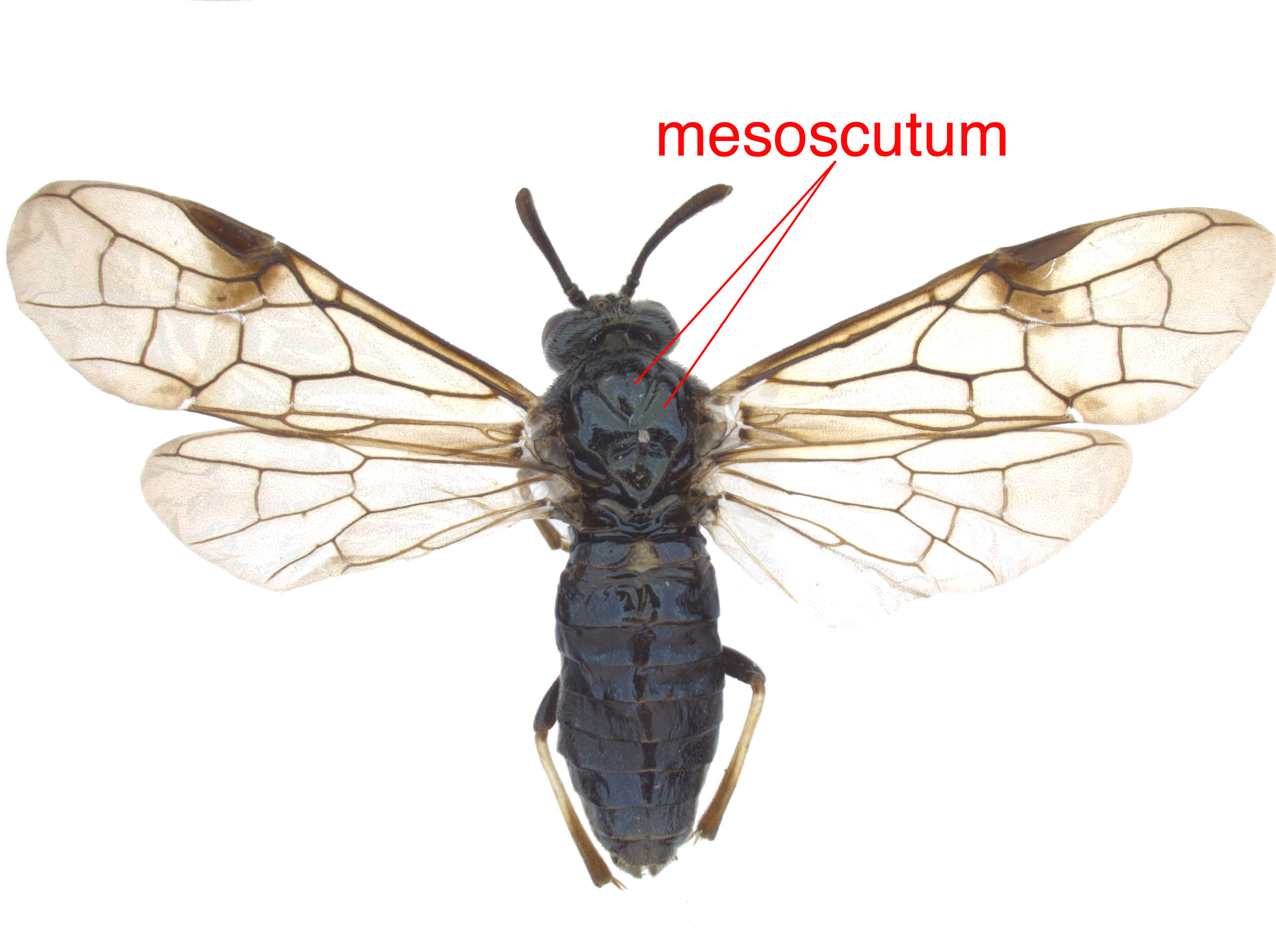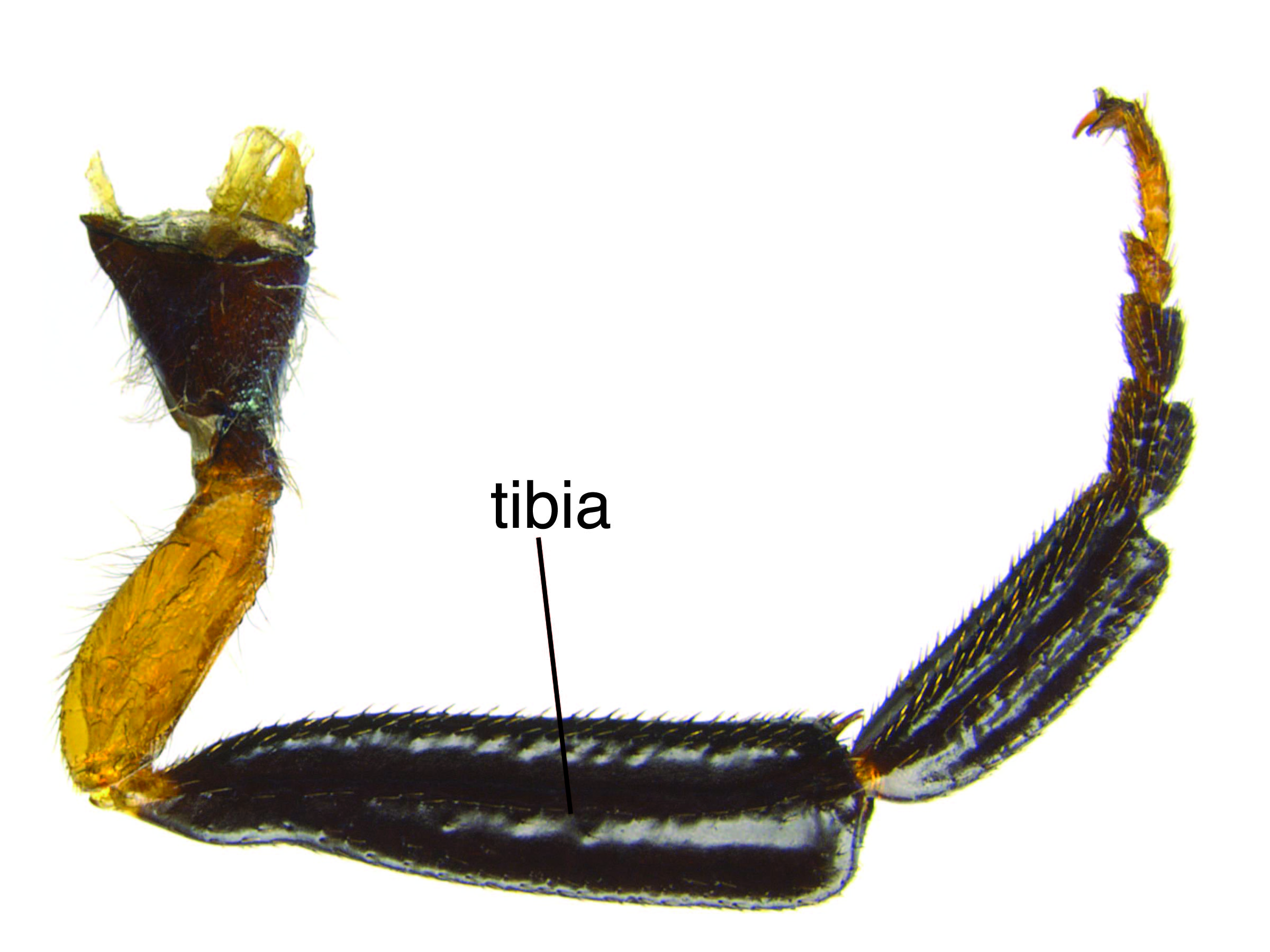Family: Tenthredinidae
Family common name: common sawflies
Subfamily: Heterarthrinae
Tribe: Fenusini
Genus: Fenusa Leach, 1817
Subgenera: Fenusa, Kaliofenusa
The Tenthredinidae are the most species-rich family and are found throughout the world, in all continents but Antarctica. They are known as the “common sawflies.” They can generally be recognized by a cylindrical body and long, segmented antennaeantenna:
the sensory organ emerging from the front of the head, usually between the compound eyes and above the clypeus; includes the flagellum, scape and pedicel
 . Otherwise, they come in a variety of colors, sizes, and forms (Goulet 1992Goulet 1992:
. Otherwise, they come in a variety of colors, sizes, and forms (Goulet 1992Goulet 1992:
Goulet H. 1992. The genera and subgenera of the sawflies of Canada and Alaska: Hymenoptera. Symphyta. The insects and arachnids of Canada. Part 20. Agriculture Canada Publication.).
Sawflies in the Heterarthrinae subfamily are generally small and dark-colored. Many species of this family are economic pests of trees and shrubs and can be characterized by their skeletonizing or leaf-mining larval feeding behaviors. Heterarthrinae adults can be distinguished from those of other subfamilies by wing venationvenation:
the network of veins on a wing
(Smith 1971aSmith 1971a:
Smith DR. 1971a. Nearctic Sawflies. III. Heterarthrinae: Adults and larvae (Hymenoptera: Tenthredinidae). Technical Bulletin, U.S. Department of Agriculture 1420: 1-84.).
Fenusa are very small, about 3.5–4 mm in length and entirely black with slightly darkened wings (Smith 1971aSmith 1971a:
Smith DR. 1971a. Nearctic Sawflies. III. Heterarthrinae: Adults and larvae (Hymenoptera: Tenthredinidae). Technical Bulletin, U.S. Department of Agriculture 1420: 1-84.). The Fenusini tribe are all leaf miners (Goulet 1992Goulet 1992:
Goulet H. 1992. The genera and subgenera of the sawflies of Canada and Alaska: Hymenoptera. Symphyta. The insects and arachnids of Canada. Part 20. Agriculture Canada Publication.). The North American Fenusa species are all pests of economically significant tree genera (Smith 1971aSmith 1971a:
Smith DR. 1971a. Nearctic Sawflies. III. Heterarthrinae: Adults and larvae (Hymenoptera: Tenthredinidae). Technical Bulletin, U.S. Department of Agriculture 1420: 1-84.).
There are 12 described extantextant:
in existence; opposite of extinct
species worldwide. Three occur in North America (Taeger et al. 2018Taeger et al. 2018:
Taeger A, Liston AD, Prous M, Groll EK, Gehroldt T, and Blank SM. 2018. ECatSymmdash;Electronic World Catalog of Symphyta (Insecta, Hymenoptera). Program version 5.0 (19 Dec 2018), data version 40 (23 Sep 2018). Senckenberg Deutsches Entomologisches Institut (SDEI), Muuml;ncheberg. https://sdei.de/ecatsym/ Accessed: 28 Jan 2020.).
A key to North American species is included in Smith 1967cSmith 1967c:
Smith DR. 1967c. A review of the subfamily Heterarthrinae in North America (Hymenoptera: Tenthredinidae). Proceedings of the Entomological Society of Washington 69: 277-284. and in Smith 1971aSmith 1971a:
Smith DR. 1971a. Nearctic Sawflies. III. Heterarthrinae: Adults and larvae (Hymenoptera: Tenthredinidae). Technical Bulletin, U.S. Department of Agriculture 1420: 1-84..
Subfamily characters
 M slightly constricted at apexapex:
M slightly constricted at apexapex: vein 2r present (Goulet 1992Goulet 1992:
vein 2r present (Goulet 1992Goulet 1992:Genus characters
 veins 2A and 3A curved upwards and meeting 1A (Smith 1967cSmith 1967c:
veins 2A and 3A curved upwards and meeting 1A (Smith 1967cSmith 1967c: cellcell:
cellcell: R1 open to margin (Smith 1967cSmith 1967c:
R1 open to margin (Smith 1967cSmith 1967c: narrow medially; membranous area large (Goulet 1992Goulet 1992:
narrow medially; membranous area large (Goulet 1992Goulet 1992: median lobe with 0–10 setaeseta:
median lobe with 0–10 setaeseta: about equal to the length of the fore and mid tibiatibia:
about equal to the length of the fore and mid tibiatibia: , respectively (Smith 1967cSmith 1967c:
, respectively (Smith 1967cSmith 1967c: simple (Smith 1967cSmith 1967c:
simple (Smith 1967cSmith 1967c:Fenusa can be confused with other genera in the subfamily, especially similar genera Profenusa and Fenella. It can be distinguished by the number of antennal segments, large membranous area behind the first tergitetergite:
a sclerotized segment of the tergum
 , open cellcell:
, open cellcell:
1. a membranous area of the wing between veins, 2. a small cavity or closed space
 R1 of the hind winghind wing:
R1 of the hind winghind wing:
the posterior wing of each pair of wings
 , and lack of a completely haired mesonotummesonotum:
, and lack of a completely haired mesonotummesonotum:
the second segment of the dorsum of the thorax
 (Goulet 1992Goulet 1992:
(Goulet 1992Goulet 1992:
Goulet H. 1992. The genera and subgenera of the sawflies of Canada and Alaska: Hymenoptera. Symphyta. The insects and arachnids of Canada. Part 20. Agriculture Canada Publication.).
none
Each of the three Fenusa species in North America are associated with a tree genus: F. dohrnii feeds on Alnus spp. (alder), F. pumila on Betula spp. (birch), and F. ulmi on Ulmus spp. (elm) (Smith 1971aSmith 1971a:
Smith DR. 1971a. Nearctic Sawflies. III. Heterarthrinae: Adults and larvae (Hymenoptera: Tenthredinidae). Technical Bulletin, U.S. Department of Agriculture 1420: 1-84.).
Females oviposit into the upper surface of leaves. LarvaeLarva:
the immature stage of holometabolous insects
 feed on the inner leaf tissue and create blotch mines in the process. At maturity, the larvaelarva:
feed on the inner leaf tissue and create blotch mines in the process. At maturity, the larvaelarva:
the immature stage of holometabolous insects
 drop to the ground and burrow into the soil to overwinter and subsequently pupate (Scannell 2000Scannell 2000:
drop to the ground and burrow into the soil to overwinter and subsequently pupate (Scannell 2000Scannell 2000:
Scannell CM. 2000. The biology and seasonal life history of the elm leaf miner, Fenusa ulmi (Sundevall), in the Pacific Northwest (Hymenoptera: Tenthredinidae) (Masterrsquo;s thesis). University of Washington., Miller and Ware 2014Miller and Ware 2014:
Miller F and Ware G. 2014. Seasonal activity, within-tree distribution, and ovipositional and feeding preference of the elm leafminer, Fenusa ulmi (Hymenoptera: Tenthredinidae). Journal of Environmental Horticulture 32 (1): 39-48.). All three species present in North America are introduced and established from their native range in Europe and western Asia (Taeger et al. 2018Taeger et al. 2018:
Taeger A, Liston AD, Prous M, Groll EK, Gehroldt T, and Blank SM. 2018. ECatSymmdash;Electronic World Catalog of Symphyta (Insecta, Hymenoptera). Program version 5.0 (19 Dec 2018), data version 40 (23 Sep 2018). Senckenberg Deutsches Entomologisches Institut (SDEI), Muuml;ncheberg. https://sdei.de/ecatsym/ Accessed: 28 Jan 2020.).
Fenusa dohrnii, known as the European alder leaf miner, and Fenusa pumila, birch leaf miner, are pests on elm and birch, respectively (Smith 1971aSmith 1971a:
Smith DR. 1971a. Nearctic Sawflies. III. Heterarthrinae: Adults and larvae (Hymenoptera: Tenthredinidae). Technical Bulletin, U.S. Department of Agriculture 1420: 1-84.). Fenusa ulmi, the elm leaf miner, is a common pest of elms and has been reported causing extensive damage on elm trees. The larvaelarva:
the immature stage of holometabolous insects
 are dorsoventrally flatteneddorsoventrally flattened:
are dorsoventrally flatteneddorsoventrally flattened:
the body is flattened from the upper and lower surfaces, like a flatworm
and have reduced thoracicthoracic:
of or on the thorax
legs. In infestations, over 100 eggs and larvaelarva:
the immature stage of holometabolous insects
 can be found in a single leaf at a time. Like many leaf miners, internal feeding behaviors protect the larvaelarva:
can be found in a single leaf at a time. Like many leaf miners, internal feeding behaviors protect the larvaelarva:
the immature stage of holometabolous insects
 from classical chemical control, making them difficult to control (Miller and Ware 2014Miller and Ware 2014:
from classical chemical control, making them difficult to control (Miller and Ware 2014Miller and Ware 2014:
Miller F and Ware G. 2014. Seasonal activity, within-tree distribution, and ovipositional and feeding preference of the elm leafminer, Fenusa ulmi (Hymenoptera: Tenthredinidae). Journal of Environmental Horticulture 32 (1): 39-48.).
World: This genus is known from North America, throughout Europe into Russia, Turkey, and Iran, and in southeastern Asia in China and Myanmar (Taeger et al. 2018Taeger et al. 2018:
Taeger A, Liston AD, Prous M, Groll EK, Gehroldt T, and Blank SM. 2018. ECatSymmdash;Electronic World Catalog of Symphyta (Insecta, Hymenoptera). Program version 5.0 (19 Dec 2018), data version 40 (23 Sep 2018). Senckenberg Deutsches Entomologisches Institut (SDEI), Muuml;ncheberg. https://sdei.de/ecatsym/ Accessed: 28 Jan 2020.)
North America: Fenusa occurs throughout northern United States and southern Canada. All three species were introduced from Europe. Fenusa dohrnii was first discovered in North America in Ottawa in 1891 and has since spread to the extent of the genus’ range today. Fenusa pumila was first found in Connecticut in 1925 and now is recorded in eastern states and provinces, and in Oregon, Washington, and Alaska in the west. Fenusa ulmi was first found in New York in 1898 and now occurs in northeastern United States west to the Great Lakes region and southeastern Canada (Smith 1971aSmith 1971a:
Smith DR. 1971a. Nearctic Sawflies. III. Heterarthrinae: Adults and larvae (Hymenoptera: Tenthredinidae). Technical Bulletin, U.S. Department of Agriculture 1420: 1-84., Snyder et al. 2007Snyder et al. 2007:
Snyder C, MacQuarrie CJ, Zogas K, Kruse JJ, and Hard J. 2007. Invasive species in the last frontier: distribution and phenology of birch leaf mining sawflies in Alaska. Journal of Forestry 105(3): 113-119., Miller and Ware 2014Miller and Ware 2014:
Miller F and Ware G. 2014. Seasonal activity, within-tree distribution, and ovipositional and feeding preference of the elm leafminer, Fenusa ulmi (Hymenoptera: Tenthredinidae). Journal of Environmental Horticulture 32 (1): 39-48.).
Map data from: GBIF.org (29 October 2019) GBIF Occurrence Download Fenusa
Details about data used for maps can be found here.